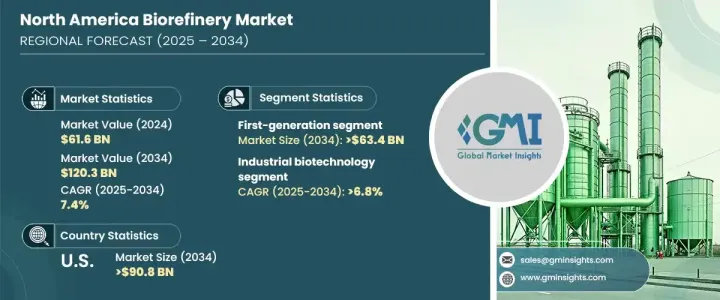PUBLISHER: Global Market Insights Inc. | PRODUCT CODE: 1684812

PUBLISHER: Global Market Insights Inc. | PRODUCT CODE: 1684812
North America Biorefinery Market Opportunity, Growth Drivers, Industry Trend Analysis, and Forecast 2025 - 2034
North America Biorefinery Market was valued at USD 61.6 billion in 2024 and is anticipated to grow at a CAGR of 7.4% between 2025 and 2034. This impressive growth is fueled by rapid technological advancements, robust government policies, and an increasing demand for sustainable bio-based products across diverse industries. As the global push for sustainability intensifies, the U.S. and Canada are leading the charge by leveraging innovative biorefining technologies. These countries are focusing on second and third-generation processes, which utilize non-food feedstocks to enhance process efficiency while minimizing environmental impact. With the rise of consumer awareness around eco-friendly alternatives, bio-based chemicals, biofuels, and bioplastics are becoming critical to reducing carbon footprints across industries.

Government measures such as the Renewable Fuel Standard (RFS) in the U.S. and Canada's carbon reduction initiatives are key drivers propelling the production of biofuels and bio-based chemicals. These policies, combined with growing investments in research and development, are ensuring North America remains at the forefront of this evolving market. The increased adoption of biofuels in the transportation sector and the rising use of bioplastics in packaging and consumer goods are contributing significantly to market expansion. Moreover, with businesses and policymakers increasingly focusing on circular economy models, the market is poised for sustained growth over the forecast period.
| Market Scope | |
|---|---|
| Start Year | 2024 |
| Forecast Year | 2025-2034 |
| Start Value | $61.6 Billion |
| Forecast Value | $120.3 Billion |
| CAGR | 7.4% |
The first-generation biorefinery segment is projected to generate USD 63.4 billion by 2034. Its growth is attributed to well-established infrastructure, cost efficiency, and high production capacities. These biorefineries primarily rely on abundant food-based feedstocks such as corn, vegetable oils, and sugarcane, which are integral to producing biofuels like ethanol and biodiesel. These biofuels are in high demand, particularly in the transportation and energy sectors, where they are widely adopted as alternatives to traditional fossil fuels. Supportive government initiatives promoting biofuels further bolster segment growth trajectory.
The industrial biotechnology segment within the North America biorefinery market is forecasted to grow at a CAGR of 6.8% through 2034. Advances in microbial fermentation, enzyme technologies, and genetic engineering are revolutionizing biomass conversion. Engineered microbes and optimized biocatalysts are enabling the efficient and sustainable production of biofuels, biochemicals, and bio-based materials. This innovative approach offers a greener and more viable alternative to traditional chemical production methods, catering to industries seeking environmentally friendly solutions.
The U.S. biorefinery market alone is projected to generate USD 90.8 billion by 2034. This growth is underpinned by strong government support, increasing demand for renewable biofuels, and continual advancements in biorefining technologies. Policies that encourage biofuel use in transportation and efforts to reduce carbon emissions are pivotal in driving this market forward, ensuring a sustainable future.
Table of Contents
Chapter 1 Methodology & Scope
- 1.1 Market definitions
- 1.2 Base estimates & calculations
- 1.3 Forecast calculation
- 1.4 Data sources
- 1.4.1 Primary
- 1.4.2 Secondary
- 1.4.2.1 Paid
- 1.4.2.2 Public
Chapter 2 Industry Insights
- 2.1 Industry ecosystem analysis
- 2.2 Regulatory landscape
- 2.3 Industry impact forces
- 2.3.1 Growth drivers
- 2.3.2 Industry pitfalls & challenges
- 2.4 Growth potential analysis
- 2.5 Porter's analysis
- 2.5.1 Bargaining power of suppliers
- 2.5.2 Bargaining power of buyers
- 2.5.3 Threat of new entrants
- 2.5.4 Threat of substitutes
- 2.6 PESTEL analysis
Chapter 3 Competitive landscape, 2024
- 3.1 Strategic dashboard
- 3.2 Innovation & sustainability landscape
Chapter 4 Market Size and Forecast, By Type, 2021 – 2034 (USD Million)
- 4.1 Key trends
- 4.2 First generation
- 4.3 Second generation
- 4.4 Third generation
Chapter 5 Market Size and Forecast, By Technology, 2021 – 2034 (USD Million)
- 5.1 Key trends
- 5.2 Industrial biotechnology
- 5.3 Physio chemical
- 5.4 Thermochemical
Chapter 6 Market Size and Forecast, By Product, 2021 – 2034 (USD Million)
- 6.1 Key trends
- 6.2 Energy driven
- 6.3 Material driven
Chapter 7 Market Size and Forecast, By Country, 2021 – 2034 (USD Million)
- 7.1 Key trends
- 7.2 U.S.
- 7.3 Canada
- 7.4 Mexico
Chapter 8 Company Profiles
- 8.1 Biogreen Synergy
- 8.2 Blue Son
- 8.3 Borregaard
- 8.4 Clariant
- 8.5 Caterpillar
- 8.6 Chevron
- 8.7 Coasan
- 8.8 DuPont
- 8.9 Future Fuel
- 8.10 Green Plains
- 8.11 Montuk Renewables
- 8.12 Neste
- 8.13 Pacific Biodiesel
- 8.14 Renewable Energy Group
- 8.15 Total Energies
- 8.16 Verbio




